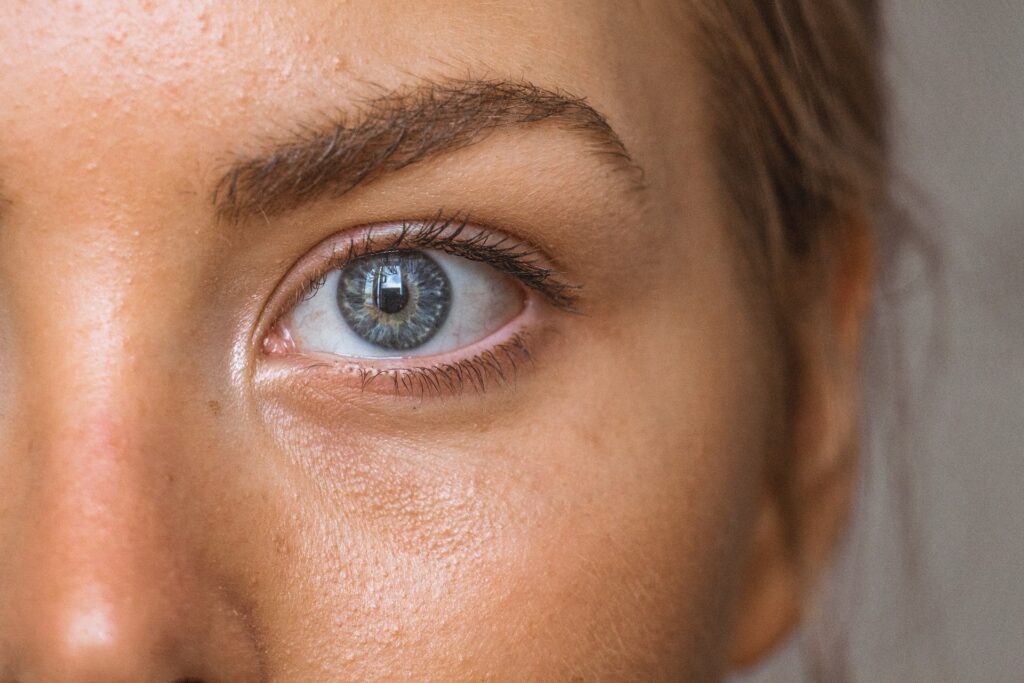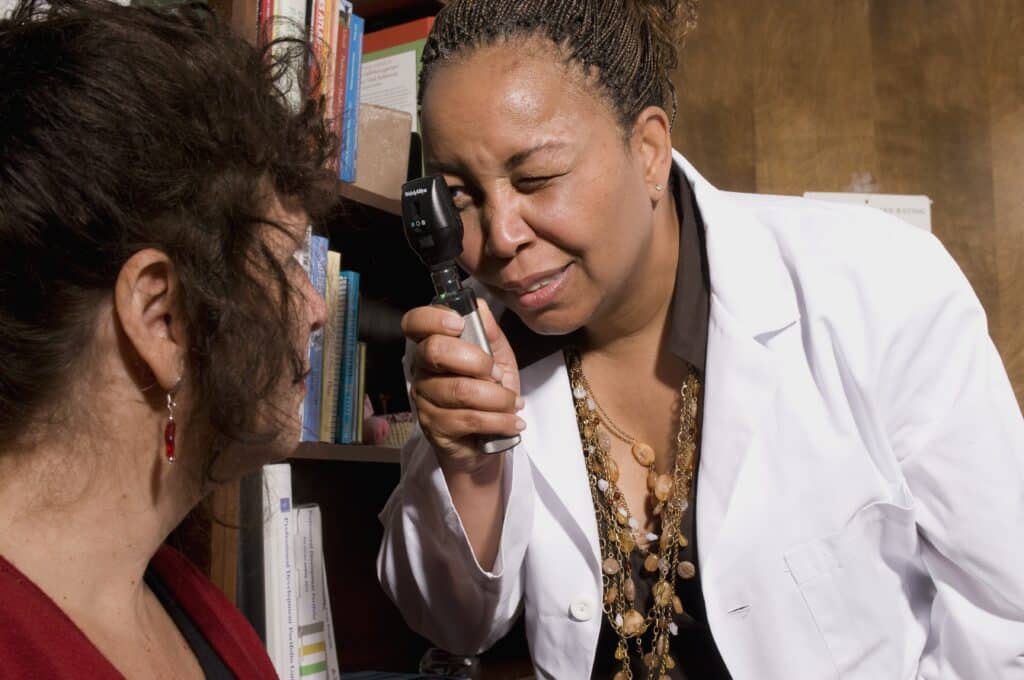Maculopathy, often referred to as macular degeneration, is an eye disease that affects the retina. This condition can lead to challenges when it comes to reading, seeing in low light, and recognizing colors and faces. As the disease progresses, patients may even experience central vision loss. While there’s no complete cure for maculopathy, treatments can help manage and slow down vision loss.
What is Maculopathy?
Maculopathy, often referred to as macular degeneration or macular retinopathy, is a condition that affects the macula, the region of the retina responsible for central vision and color perception. People with maculopathy don’t experience total vision loss; however, they can lose their central vision. As the condition progresses, some patients could be identified as having central vision loss significant enough to be considered legally blind.
Maculopathy comes in several forms, but the most prevalent is age-related macular degeneration (AMD), which typically affects diabetic patients and those of advancing age. While there’s no cure for maculopathy, treatments can include medication, dietary supplements, eye drops, and lifestyle changes. Optical coherence tomography may also be used to monitor the progress of the disease.
What Causes Maculopathy?
Maculopathy often occurs due to the natural aging process. As time goes on, the macula deteriorates, leading to central vision loss. One theory suggests maculopathy comes from eye inflammation or abnormal blood vessels that release fluid into the retina, disturbing the vision.
Diabetes is a significant health condition that increases the risks of maculopathy. For instance, according to a paper from J Ophthalmol, diabetic maculopathy is a leading cause of vision loss in diabetic patients. Certain medications could also harm the retina and cause maculopathy.
There are many risk factors for maculopathy, including:
- Age over 50
- Diabetes
- High blood pressure
- Family history and genetic factors
- Smoking
- Obesity
- Cardiovascular diseases
- Elevated cholesterol levels
- Consuming a diet rich in saturated fats
- Race (with Caucasians at an increased risk)
- Specific medicines, including hydroxychloroquine and Elmiron (pentosan polysulfate sodium)
In 2020, Janssen Pharmaceuticals, a subsidiary of Johnson & Johnson, added a warning for pigmentary maculopathy to its Elmiron drug label. Elmiron is an interstitial cystitis medication, and research shows that pigmentary maculopathy only affects patients who have taken it.
Patients who were diagnosed vision loss and maculopathy after taking the medication filed Elmiron lawsuits against Johnson & Johnson, claiming the company sold a faulty medication and neglected to notify the public about its potential risks.

Symptoms of Maculopathy
Symptoms of maculopathy can vary by type, and might not always be obvious until the condition advances. Generally, symptoms of this macular disease include blurred vision, trouble adapting to low light, and central vision loss.
The most maculopathy symptoms include:
- Distorted or blurred vision
- Spots in the vision
- Struggling to adjust to dim lighting
- Impaired night vision
- Reading problems
- Straight lines appearing wavy
- Color vision loss
- Reduced depth perception
5 Types of Maculopathy
The most common form of maculopathy is age related macular degeneration. However, there are other types, such as diabetic maculopathy, pigmentary maculopathy, myopic maculopathy (sometimes known as macular pucker), and malattia leventinese (a form of hereditary maculopathy).
Age Related Macular Degeneration
According to the American Academy of Ophthalmology, age related macular degeneration (AMD) often affects people over the age of 50. It’s estimated that nearly 20 million Americans are affected by some form of age related macular degeneration.
There are two types of age related macular degeneration: Wet and dry. Dry age related macular degeneration is the most common type, and is caused by macular thinning due to age. Wet age related macular degermation, on the other hand, is less common but more severe. It’s caused by abnormal blood vessels growing into the macula and leaking fluid.
Patients with wet age related macular degeneration typically lose their vision faster than those suffering from the dry version.
Hereditary Maculopathy
Hereditary maculopathy is an inherited form of macular disease, often referred to as juvenile macular degeneration. The most common types include vitelliform macular dystrophy (also called Best disease) and Stargardt macular degeneration.
Stargardt macular degeneration is characterized by the accumulation of fatty pigment in the macula. Its severity tends to worsen over time. Exposure to bright lights can exacerbate the buildup of this fatty pigment.
Vitelliform macular dystrophy is rarer, and stems from gene mutations that cause fat deposits to build up in the macula.
Diabetic Maculopathy
Diabetic maculopathy, often referred to as diabetic retinopathy, happens when elevated blood sugar levels cause damage to the retina. When diabetes affects blood vessels in the eye, the body produces new, abnormal blood vessels that are prone to leakage or bleeding. Diabetic maculopathy can develop in patients with any form of diabetes.
In its early stages, patients might notice any symptoms. However, as the abnormal blood vessels begin to bleed, people will start to see dark floaters or streaks resembling cobwebs in their vision. As the condition progresses, central vision loss intensifies. If left untreated, it can result in complications like glaucoma and retinal scarring.
Macular Pucker
Macular pucker is a form of maculopathy that occurs when scar tissue develops on the macula. It pulls on the macula, which causes it to wrinkle. This condition results in symptoms like blurry vision, distorted central vision, a gray spot in the middle of your vision, and problems reading fine details.
This macular disease generally remains stable without worsening, and can affect one eye or both.
Pigmentary Maculopathy
Pigmentary maculopathy is a specific type of maculopathy linked to Elmiron. Common symptoms include blurred vision, difficulties reading, and struggling to adapt to dim lighting. These vision problems are included in Elmiron’s prescribing pamphlet. Currently, there is no treatment to fully reverse this condition.
In 2018, ophthalmologists began discussing pigmentary maculopathy in a number of medical journals. According to Drs. Adam M. Hanif and Nieraj Jain in the Review of Ophthalmology, this condition can sometimes be misdiagnosed as age related macular degeneration. To date, pigmentary maculopathy has only been diagnosed in patients who have taken Elmiron.
Retinal damage from this type of maculopathy usually happens after a patient has been taking Elmiron for an extended period of time—typically more than three years. However, there have been reported cases with shorter durations of use. Alarmingly, vision loss may last even after patients have stopped taking Elmiron.
How is Maculopathy Diagnosed?
Ophthalmologists diagnose maculopathy by conducting a thorough eye exam, looking for any abnormalities in the retina or macula. Depending on their findings, they may order more detailed tests.
Some of the diagnostic procedures for maculopathy include:
- Dilated eye exam: In this procedure, the patient is given eye drops to dilate the pupils. Then, the doctor examines the inside of the eye using a special lens.
- Fluorescein angiography: In this test, a yellow dye is injected into a vein—typically in the arm. As this dye circulates through the eye’s blood vessels, eye doctors can detect leaks within the macula.
- Optical coherence tomography (OCT): This advanced imaging technique captures detailed pictures of the back of the eye.
- Optical coherence tomography angiography (OCTA): Using laser reflections and special scanning equipment, this test generates 3D images of the blood circulating in the eye.
- Visual field test: This might involve the use of an Amsler grid. If the patient perceives the lines as distorted, wavy, blurred, or fragmented, it could signify the progression of macular disease.

Maculopathy Treatment Options
Maculopathy cannot be cured or reversed. The primary goal of treatment is to slow down its progression and mitigate vision loss.
The most common maculopathy treatments involve medications, nutritional supplements, laser treatment, and, in some instances, surgical procedures.
Types of Maculopathy and Treatments
| TYPE | TREATMENT |
|---|---|
| Pigmentary maculopathy | – Avoid long-term exposure to Elmiron |
| – Medications like corticosteroids, topical carbonic anhydrase inhibitors, oral acetazolamide, and nonsteroidal anti-inflammatory agents. | |
| – Anti-VEGF eye injections to reduce new blood vessels growth in the eye | |
| Dry age related macular degeneration | – Vitamins and minerals like AREDS and AREDS2 |
| – Diets rich in yellow fruits, fish, vegetables, and dark leafy greens | |
| Wet age related macular degeneration | – Anti-VEGF eye injections to slow down new blood vessels growth in the eye |
| – Photodynamic therapy to clot and seal abnormal blood vessels | |
| Diabetic maculopathy | – Anti-VEGF eye injections to reduce new blood vessels growth in the eye |
| – Corticosteroids | |
| – Laser treatment for reducing swelling | |
| – Surgery to remove eye scarring | |
| Macular pucker | – Mild cases might not require treatment |
| – Serious cases may need surgery to eliminate the gel-like fluid in the back of the retina, allowing the macula to flatten and resolve vision issues | |
| Hereditary maculopathy | – Using hats and sunglasses to shield the eyes from bright light in order to avoid fatty pigment development in the eyes (specifically for Stargardt macular degeneration) |
| – Anti-VEGF eye injections to reduce new blood vessel development in the eye (particularly for vitelliform macular dystrophy) | |
| – Photodynamic therapy (for vitelliform macular dystrophy) |
Early detection of maculopathy through routine eye check-ups can help patients get the appropriate treatment in a timely manner and slow down the progression of vision loss.
If you are diagnosed with maculopathy, it is highly recommended that you consult with multiple eye doctors to ensure an accurate diagnosis and to prevent unnecessary or ineffective treatments. For instance, pigmentary maculopathy can sometimes be mistakenly identified as age related macular degeneration.
References
- https://www.aao.org/eye-health/diseases/amd-macular-degeneration
- https://www.aao.org/focalpointssnippetdetail.aspx?id=04233cba-5975-42fa-81a2-a87ae19edebd
- https://www.brightfocus.org/macular/article/age-related-macular-facts-figures
- https://www.clevelandclinic.org/health/diseases/15246-age-related-macular-degeneration
- https://www.clevelandclinic.org/health/diseases/14207-macular-pucker
- https://eyewiki.aao.org/Pentosan_Polysulfate_Maculopathy
- https://www.hopkinsmedicine.org/health/treatment-tests-and-therapies/photodynamic-therapy-for-agerelated-macular-degeneration
- https://www.mayoclinic.org/diseases-conditions/retinal-diseases/symptoms-causes/syc-20355825
- https://www.mayoclinicproceedings.org/article/S0025-6196(21)00312-8/fulltext
- https://www.microchirurgiaoculare.com/en/maculopathy/causes-and-symptoms/
- https://www.ncbi.nlm.nih.gov/pmc/articles/PMC7012292/
- https://www.nei.nih.gov/learn-about-eye-health/eye-conditions-and-diseases/diabetic-retinopathy
- https://www.nei.nih.gov/learn-about-eye-health/eye-conditions-and-diseases/macular-pucker
- https://oxfordmedicine.com/view/10.1093/med/9780199544967.001.0001/med-9780199544967-chapter-6
- https://www.reviewofophthalmology.com/article/clinical-pearls-for-a-new-condition
- https://www.accessdata.fda.gov/drugsatfda_docs/label/2021/020193Orig1s015lbl.pdf
